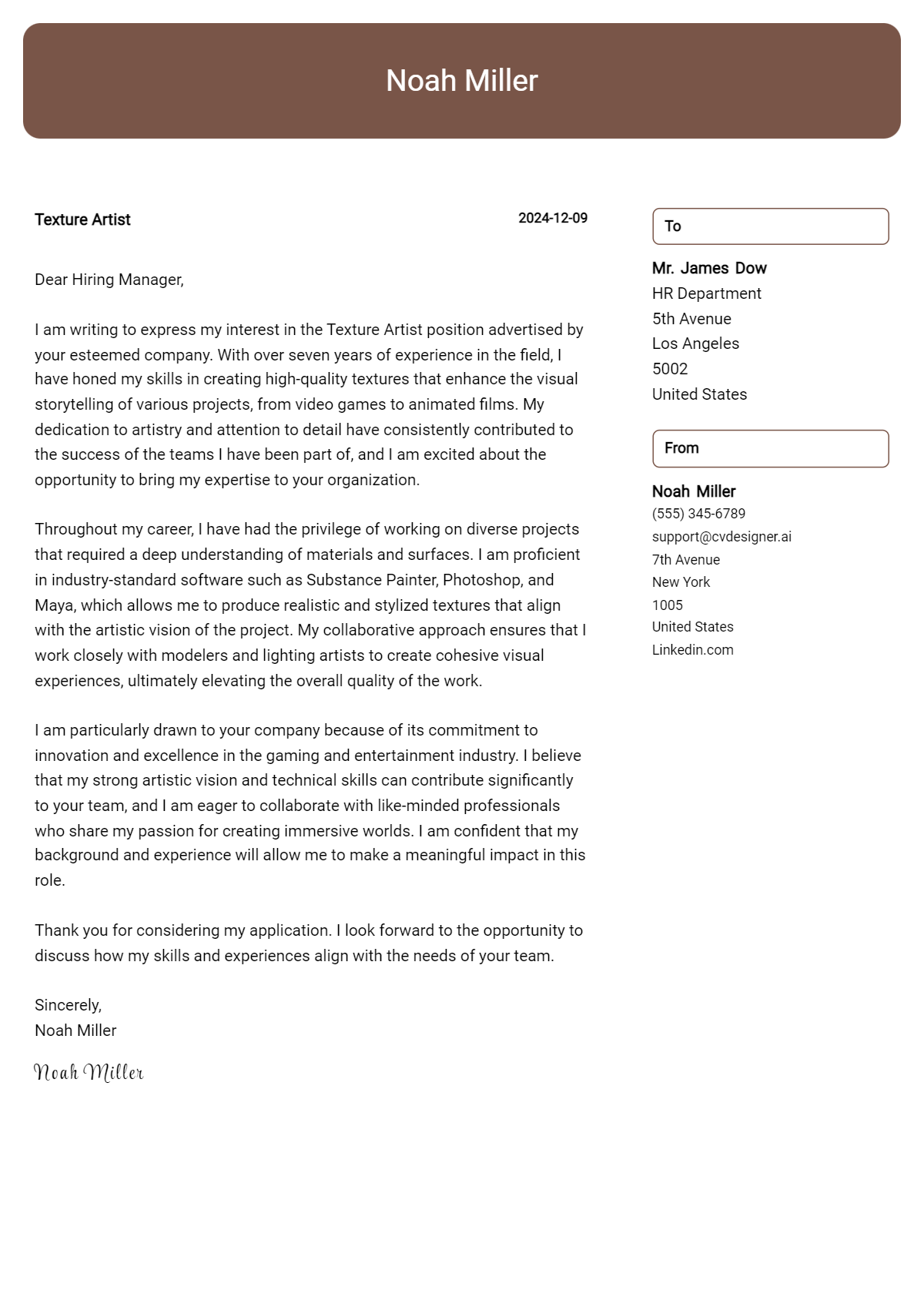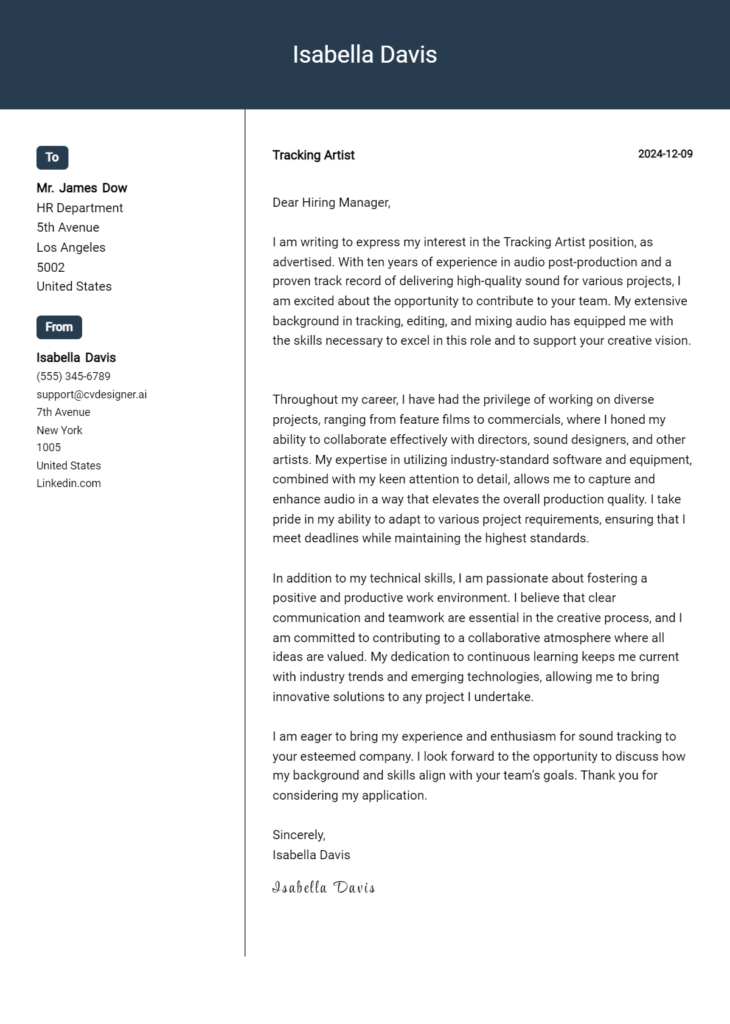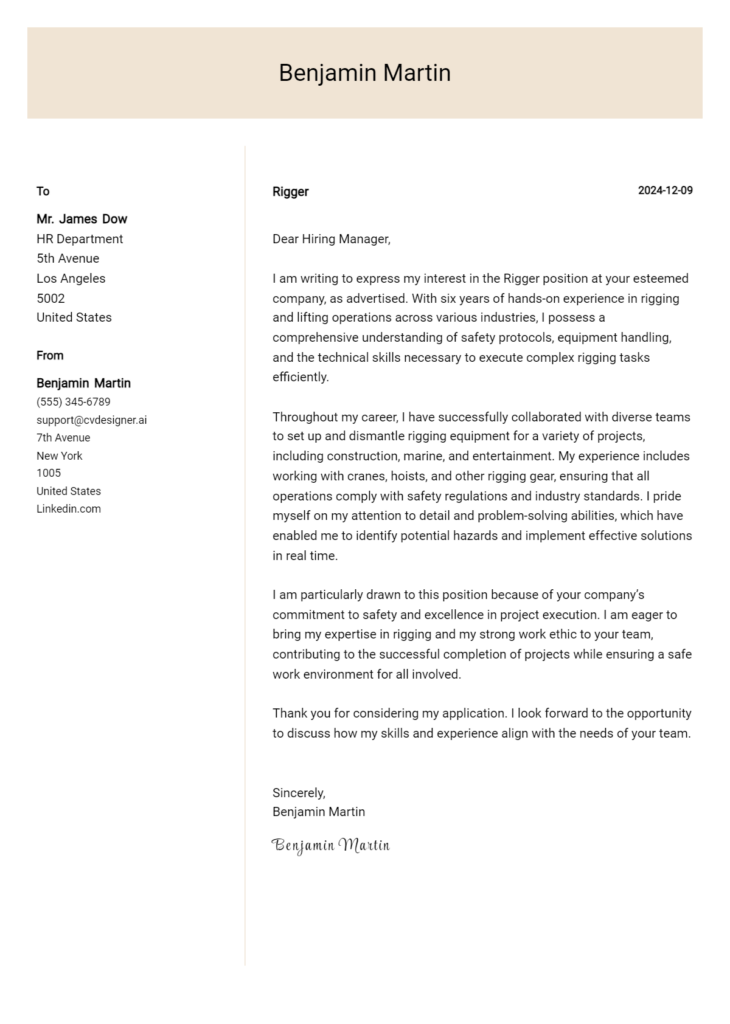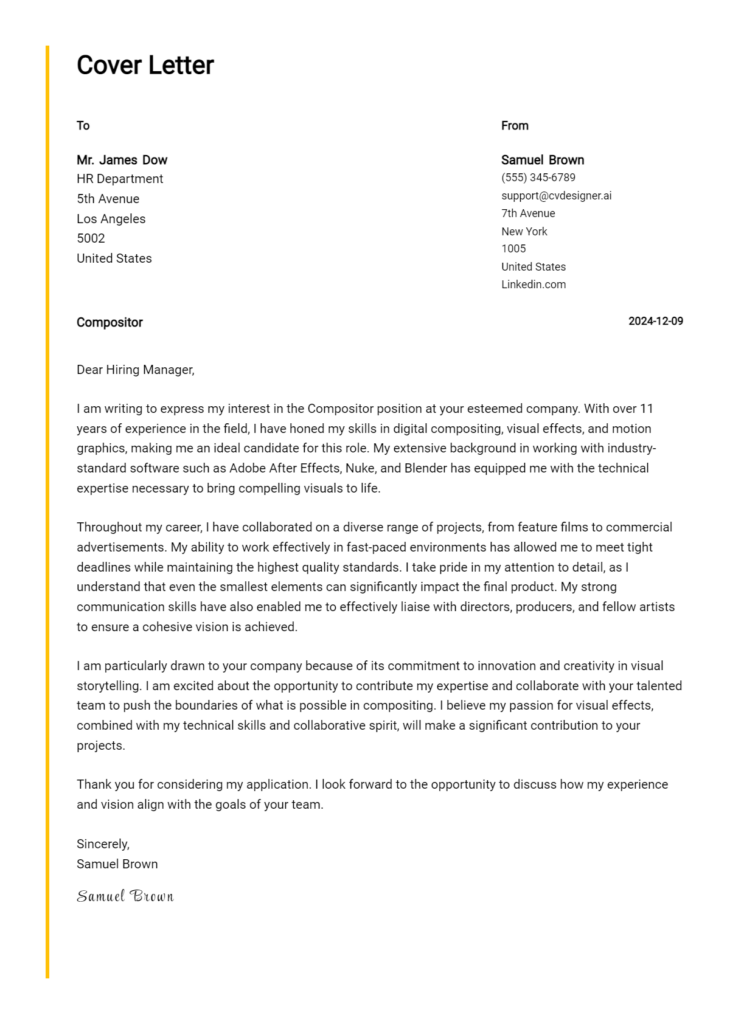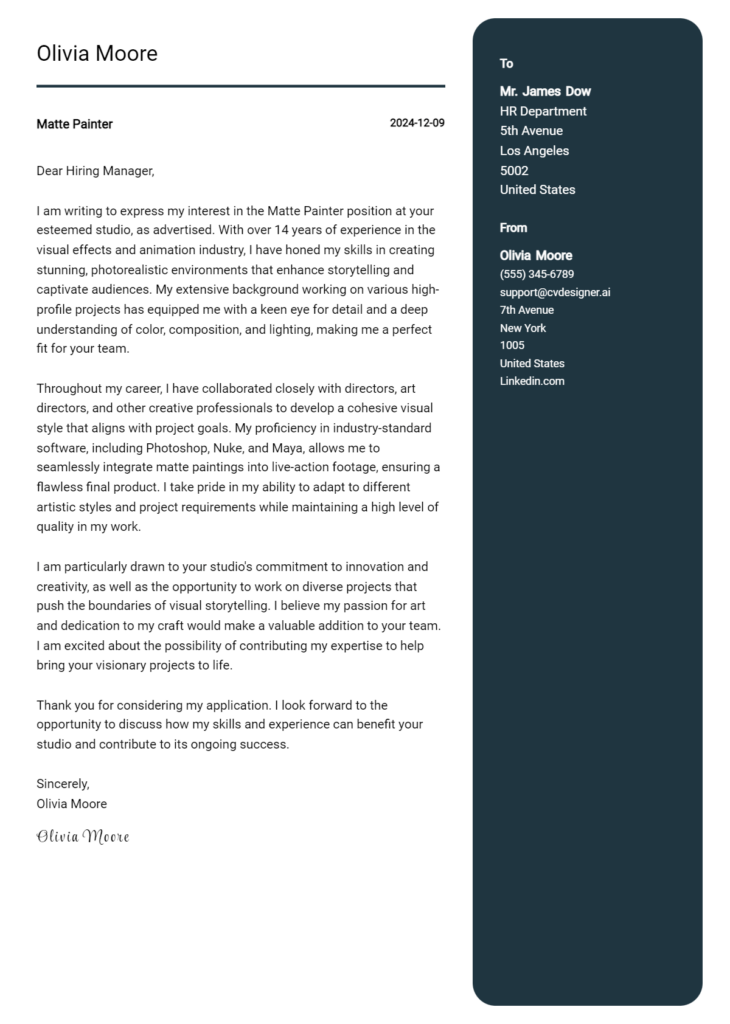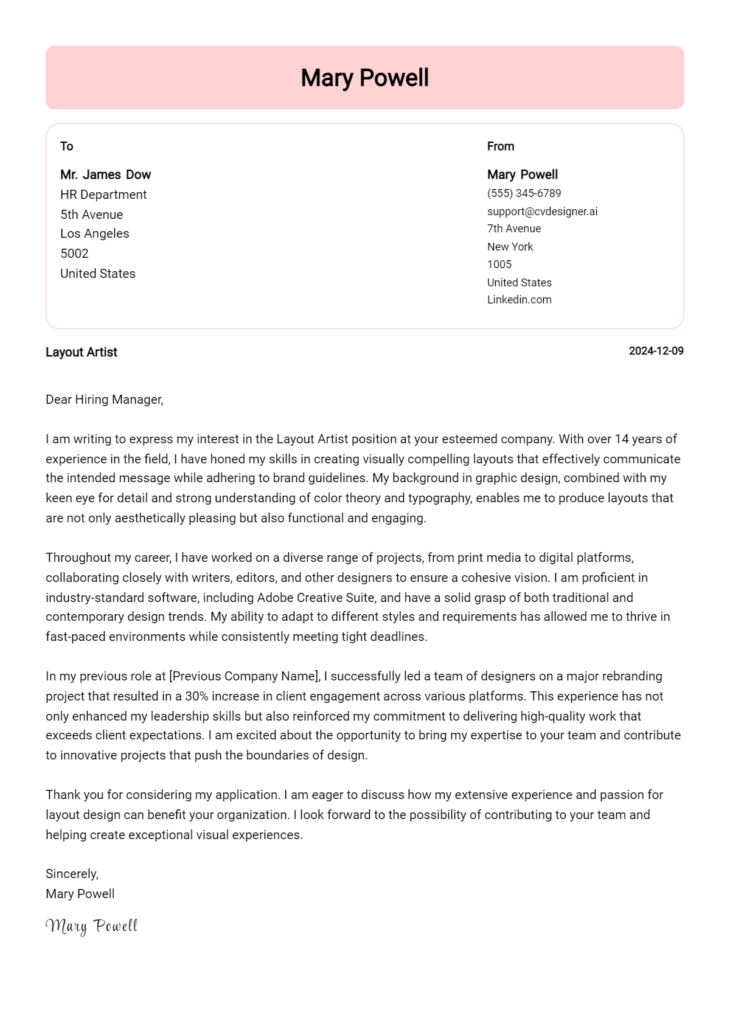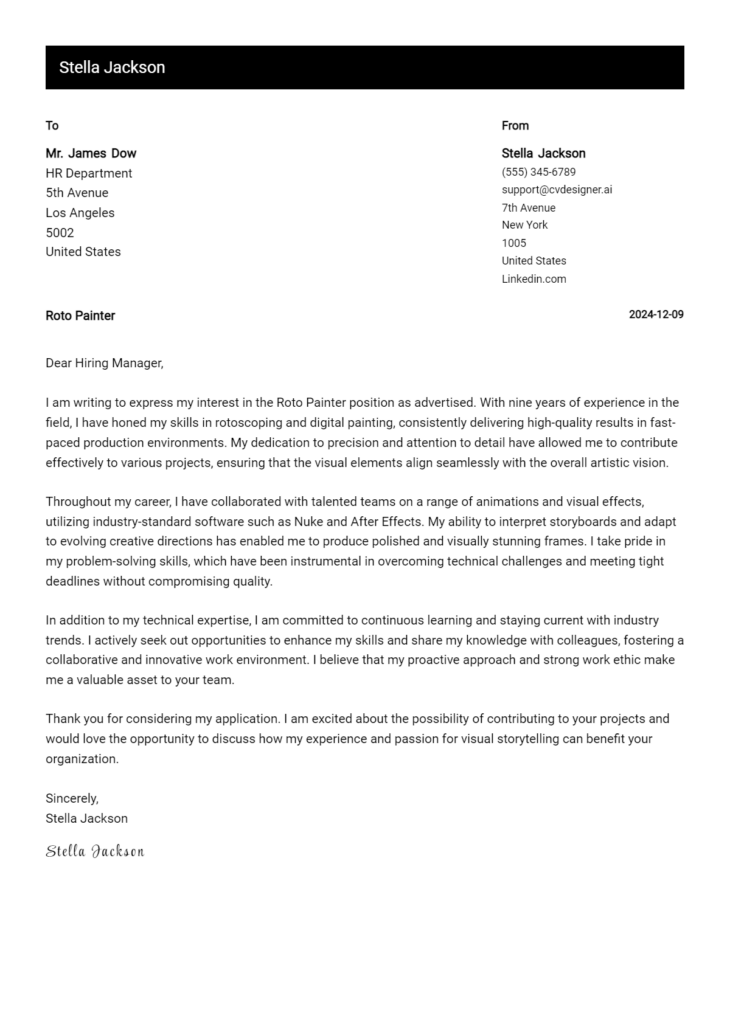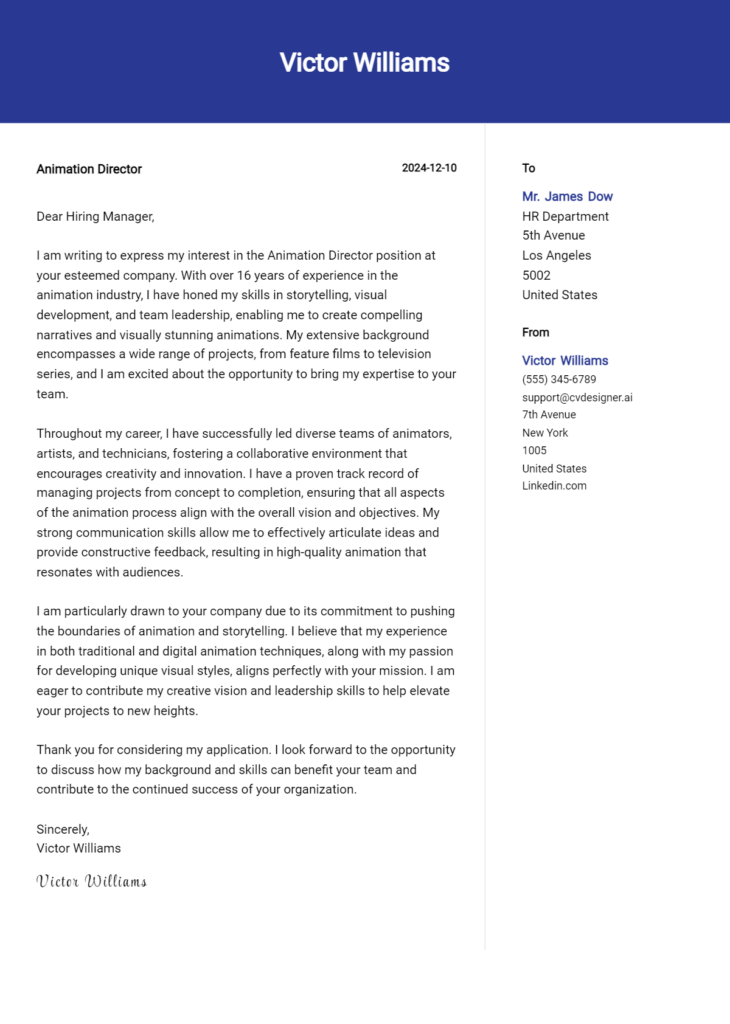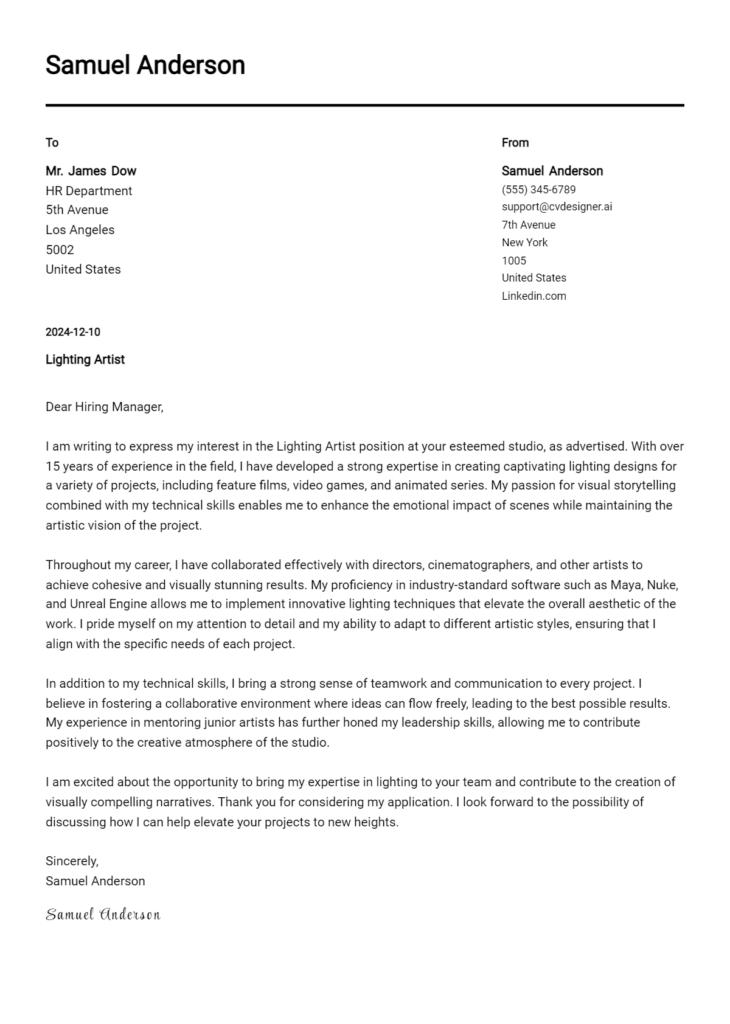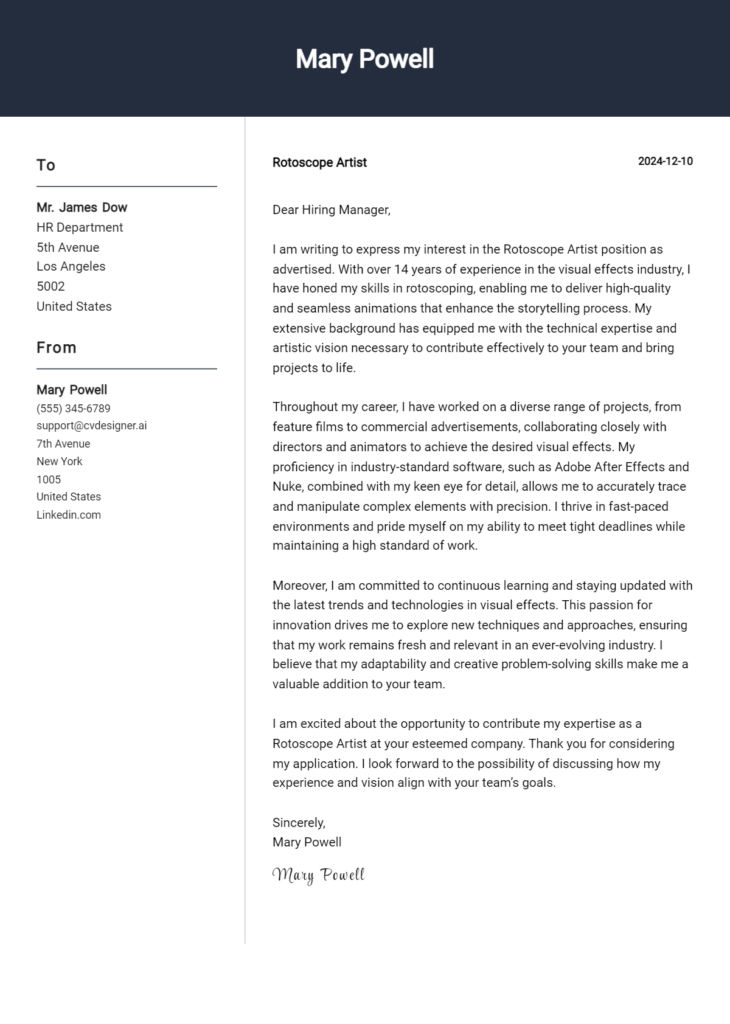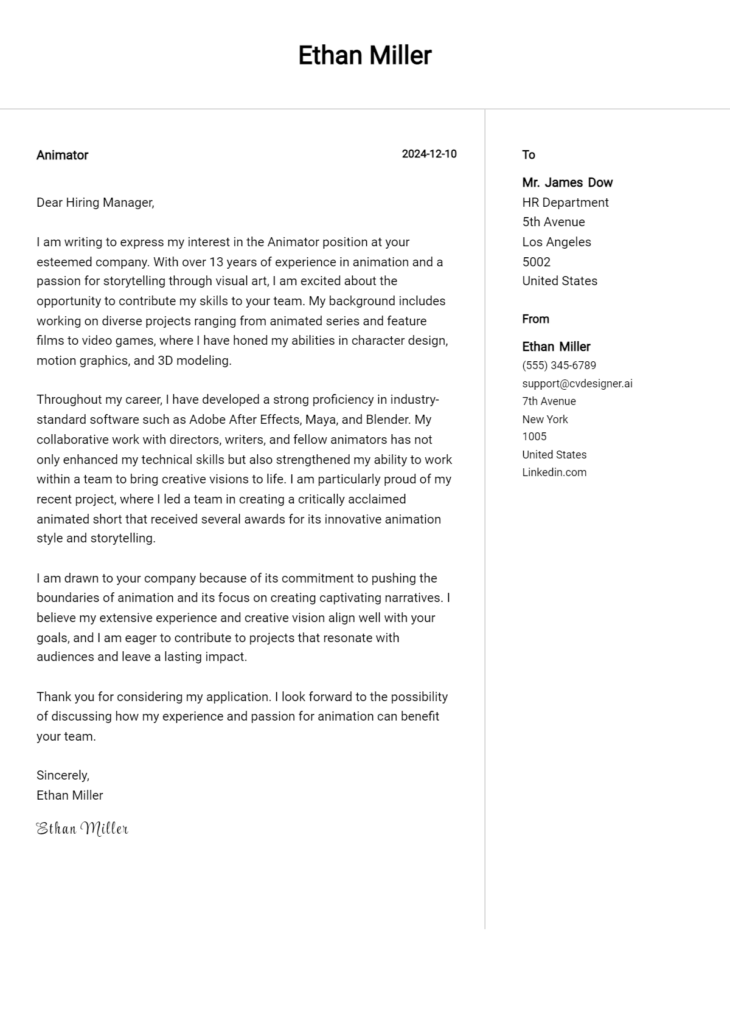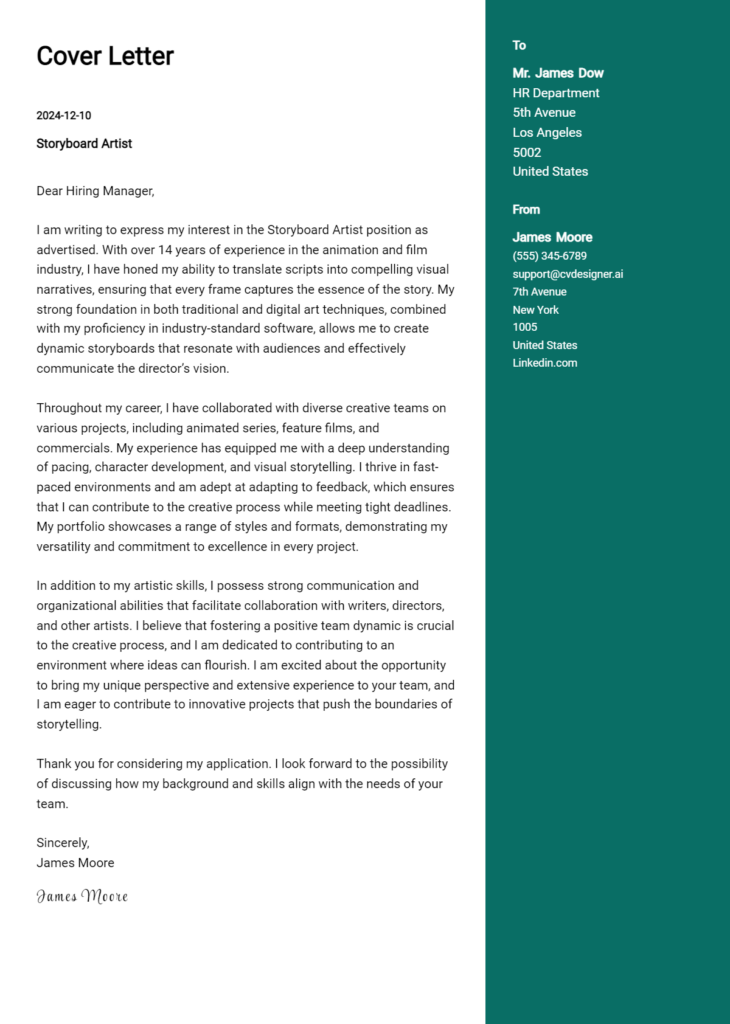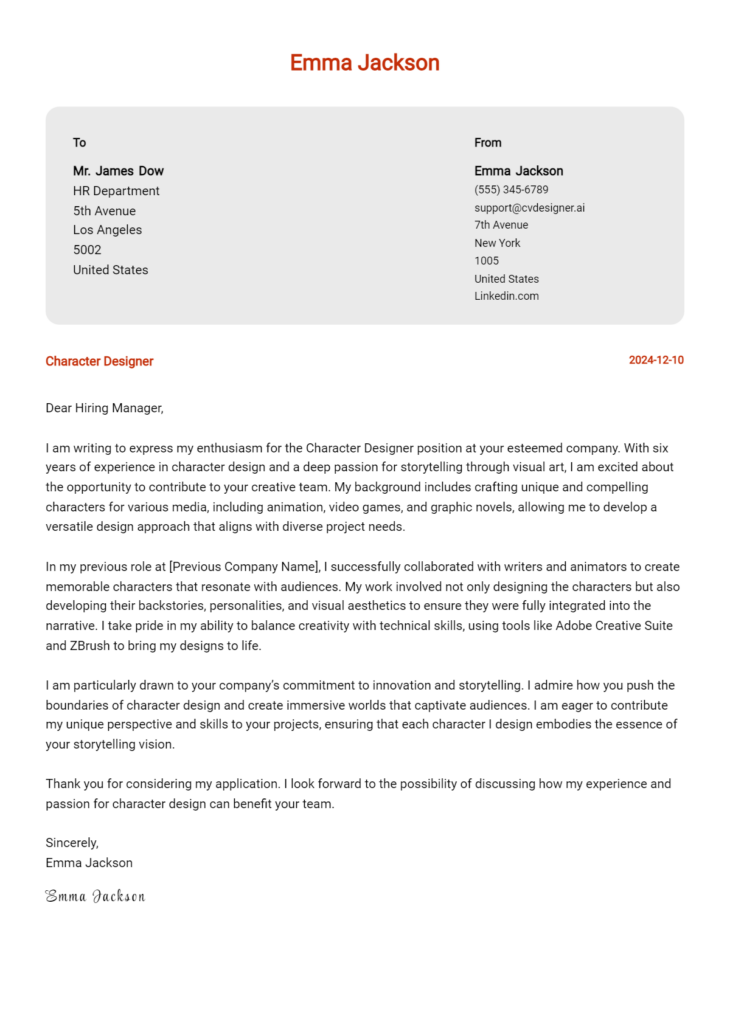Texture Artist Cover Letter Examples
Explore additional Texture Artist cover letter samples and guides and see what works for your level of experience or role.
How to Format a Texture Artist Cover Letter?
Crafting an effective cover letter is essential for a Texture Artist, as it not only showcases your artistic skills but also highlights your attention to detail and creativity. The way you format your cover letter can significantly influence the hiring manager's perception of your work ethic and professionalism. A well-structured cover letter allows you to present your unique qualities and experiences in a clear and engaging manner, making it easier for employers to see the potential you bring to their projects.
In this guide, we’ll explore how to structure your cover letter effectively, providing insights and examples specifically tailored for Texture Artists.
We will focus on the key components of a professional cover letter, including:
- Cover Letter Header
- Cover Letter Greeting
- Cover Letter Introduction
- Cover Letter Body
- Cover Letter Closing
Each section is crucial in emphasizing your qualifications and artistic vision. Let's dive into each part to help your Texture Artist cover letter shine.
Importance of the Cover Letter Header for a Texture Artist
The cover letter header is a crucial component of your application as a Texture Artist. It sets the tone for the rest of the document and provides essential information at a glance. A well-structured header should include your contact information, the date, and the recipient's details, ensuring clarity and professionalism. This not only helps the hiring manager quickly identify who you are and how to reach you, but it also reflects your attention to detail, which is vital in the artistic field. A strong header can make a positive first impression, while a weak one can detract from the overall quality of your application.
Strong Example
John Doe 123 Texture Lane Art City, CA 90210 johndoe@email.com (123) 456-7890 October 1, 2023 Jane Smith Hiring Manager Creative Studio 456 Design Ave Art City, CA 90210
Weak Example
Hey there, My name is John and I want to apply for the Texture Artist job. Thanks!
The Importance of the Cover Letter Greeting
The greeting of your cover letter is crucial as it sets the tone for the entire document and establishes a connection with the reader. A well-crafted greeting demonstrates professionalism and shows that you have taken the time to personalize your application. Addressing the hiring manager directly can make a significant impact, as it conveys your genuine interest in the position and the company. To avoid sounding generic, it's essential to do some research to find the recipient's name, which can often be found on the company’s website or through networking platforms like LinkedIn. A personalized greeting can help you stand out in a competitive field, particularly for specialized roles such as a Texture Artist.
Strong Greeting Example
Dear Ms. Johnson,
Weak Greeting Example
To Whom It May Concern,
The Importance of a Compelling Cover Letter Introduction for a Texture Artist
A well-crafted cover letter introduction is crucial for a Texture Artist as it serves as the first impression to the hiring manager. This brief yet impactful opening should not only capture attention but also convey genuine interest in the position while highlighting relevant skills and achievements. A strong introduction showcases your passion for texture artistry and sets the tone for the rest of the letter, making you stand out in a competitive field. Conversely, a weak introduction can fail to engage the reader and may lead to your application being overlooked. Below are examples that illustrate the difference.
Strong Example
Dear [Hiring Manager's Name], As a passionate Texture Artist with over five years of experience in creating photorealistic textures for AAA video games, I am excited to apply for the Texture Artist position at [Company Name]. My dedication to the craft has not only honed my skills in substance creation and UV mapping but also led to significant contributions to award-winning projects, such as [Notable Game Title]. I am eager to bring my expertise in digital artistry and my enthusiasm for innovative design to your talented team.
Weak Example
Hello, I am writing to apply for the Texture Artist job. I have some experience in this field, and I think I could do well. I have worked on a few projects and know how to use some software. I hope you consider my application.
Purpose of the Cover Letter Body for a Texture Artist
The body of a cover letter for a Texture Artist serves as a vital platform to articulate the candidate's technical skills, artistic vision, and relevant experiences in the field. This section is an opportunity to showcase specific projects that highlight their expertise in creating high-quality textures for various mediums, such as video games, films, or animations. By detailing accomplishments—like successful collaborations on well-known projects or innovative techniques that improved workflow—the candidate can effectively communicate their value to the company and demonstrate how they can contribute to the team's success.
Strong Example
Dear Hiring Manager, I am excited to apply for the Texture Artist position at [Company Name]. In my previous role at [Previous Company], I played a key role in developing textures for the critically acclaimed game [Game Title], where I implemented a unique blend of hand-painted and photorealistic techniques. This contributed to the immersive visual experience that garnered positive reviews. Additionally, I initiated a texture library system that increased workflow efficiency by 30%, allowing our team to focus more on creative aspects. I am eager to bring my passion for texture creation and my proven track record of successful projects to your innovative team. Sincerely, [Your Name]
Weak Example
Dear [Hiring Manager], I want to apply for the Texture Artist position. I have done some work in the past, and I know how to make textures. I think I could be a good fit for your company. I am a hard worker, and I am excited about the opportunity. I have worked on different projects, but I can’t remember all the details. I hope to hear from you soon. Best, [Your Name]
Importance of the Cover Letter Closing for a Texture Artist
The closing paragraph of a cover letter is a critical component for a Texture Artist, as it provides an opportunity to summarize qualifications, express enthusiasm for the role, and encourage the hiring manager to take the next steps. A strong closing leaves a lasting impression and reinforces the candidate's suitability for the position, while a weak closing can diminish the overall impact of the application. Here are examples of both strong and weak cover letter closings:
Strong Example
I am excited about the opportunity to bring my extensive experience in texture creation and my passion for visual storytelling to your talented team. My background in 3D modeling and my proficiency with industry-standard software make me a perfect fit for the Texture Artist role at [Company Name]. I would love the chance to discuss how my skills can contribute to your projects. I look forward to the possibility of an interview and will be happy to provide any additional information needed.
Weak Example
Thanks for considering my application. I hope you like my resume. Let me know if you want to talk.
These tips will guide candidates in crafting an effective cover letter for a Texture Artist position. A well-structured cover letter is crucial for showcasing your technical skills, problem-solving abilities, knowledge of the Software Development Life Cycle (SDLC), teamwork experience, and a genuine passion for continuous learning in the ever-evolving field of game design and 3D modeling.
Tips for Crafting an Effective Cover Letter for Texture Artists
Highlight Technical Skills: Clearly articulate your proficiency in industry-standard software such as Substance Painter, Maya, or Blender. Mention specific techniques you excel at, such as UV mapping or material creation. Providing examples of past projects where you utilized these skills can strengthen your case.
Showcase Problem-Solving Abilities: Discuss instances where you faced challenges during a project and how your creative solutions contributed to the final outcome. Emphasizing how you approached problems can demonstrate your critical thinking and adaptability, which are essential traits for a Texture Artist.
Demonstrate SDLC Knowledge: Illustrate your understanding of the Software Development Life Cycle by outlining how you collaborate with various teams throughout different phases of development. Mention your experience in integrating textures seamlessly into assets and how this knowledge makes you a valuable asset to the team.
Emphasize Teamwork: Texture artists often work closely with modelers, animators, and other artists. Share experiences where effective communication and collaboration led to successful project outcomes. Highlight your ability to accept and provide constructive feedback, as this is vital in a team environment.
Express Passion for Continuous Learning: The art and technology behind texturing are constantly evolving. Mention any courses, workshops, or self-directed learning you have undertaken to stay current in the field. This demonstrates your commitment to professional growth and your enthusiasm for bringing innovative techniques to your work.
For additional assistance, consider exploring cover letter templates or utilizing a cover letter builder to create a polished and professional application.
Common Mistakes to Avoid in a Texture Artist Cover Letter
Crafting a compelling cover letter is essential for a Texture Artist to stand out in a competitive job market. Avoiding common mistakes can dramatically enhance your chances of securing an interview. Here are some prevalent pitfalls and tips on how to steer clear of them:
Generic Greetings: Using a vague salutation like "To Whom It May Concern" can seem impersonal. Instead, research the hiring manager's name and personalize your greeting.
Lack of Specificity: Failing to mention specific skills or projects relevant to the job can make your letter forgettable. Tailor your content to highlight your experience with particular software or techniques in texture creation.
Overly Long Content: A cover letter that is too lengthy can lose the reader's attention. Aim for a concise format that clearly communicates your qualifications in a few paragraphs. For guidance on cover letter format, ensure your letter is well-structured.
Ignoring the Job Description: Not aligning your skills with the job requirements can hurt your chances. Carefully read the job listing and address the specific skills and experiences they are looking for.
Typos and Grammatical Errors: Mistakes in your cover letter can give a negative impression. Always proofread your letter or ask someone else to review it before submission.
Neglecting to Showcase Your Portfolio: Failing to mention your portfolio can be a missed opportunity. Include a link to your work to give potential employers a tangible sense of your skills.
Using Clichés: Phrases like "team player" or "hardworking" are overused and can make your cover letter blend in. Instead, provide concrete examples of your contributions to projects or teams that demonstrate these qualities.
By steering clear of these common mistakes, you can create a more impactful cover letter. For inspiration, check out some cover letter examples to find effective ways to present your unique qualifications as a Texture Artist.
Cover Letter FAQs for Texture Artist
What should I include in my cover letter as a Texture Artist?
As a Texture Artist, your cover letter should highlight your skills in creating realistic and stylized textures, as well as your proficiency with relevant software like Substance Painter, Adobe Photoshop, and Maya. Begin with a strong opening that captures your passion for texture creation, followed by specific examples of projects you've worked on that demonstrate your expertise. Mention any relevant education or training, such as degrees in game design or 3D art. Don’t forget to showcase your ability to collaborate with other artists and departments, as teamwork is often crucial in game and film production environments.
How do I tailor my cover letter for a specific job application?
To tailor your cover letter, carefully read the job description and identify the key skills and experiences the employer values most. Reference these points directly in your cover letter, aligning your qualifications with their needs. For instance, if the job emphasizes experience with creating textures for character models, describe a relevant project where you excelled in that area. Additionally, research the company’s style and projects, and incorporate this understanding into your letter to demonstrate your genuine interest in the role and how you can contribute to their specific artistic vision.
How can I demonstrate my artistic style and skills in my cover letter?
While a cover letter primarily serves as an introduction, you can still convey your artistic style by describing your approach to texture creation. Discuss how your techniques enhance the storytelling aspect of the visuals in your work. Mention specific styles you excel in, whether realistic, stylized, or abstract, and how you adapt your textures to fit different projects. Additionally, include links to your portfolio or relevant work samples within the letter, ensuring that potential employers can easily view your artistic capabilities and understand your unique contributions to past projects.
Should I mention my experience working in teams in my cover letter?
Absolutely! Collaboration is essential in the role of a Texture Artist, as you often work closely with 3D modelers, animators, and other artists. Highlighting your experience in team settings can demonstrate your ability to communicate effectively and integrate feedback into your work. Provide examples of successful projects where teamwork played a key role, detailing how you contributed to the overall vision. This not only showcases your artistic skills but also portrays you as a cooperative and adaptable team member, qualities that are highly valued in the creative industry.
Build your Cover Letter in minutes
Use an AI-powered cover letter builder and have your letter done in 5 minutes. Just select your template and our software will guide you through the process.

